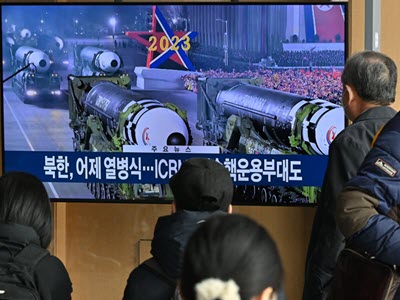Deterrence Concerns on the Korean Peninsula and South Korean Discourse on Nuclear Armament
Seukhoon Paul Choi examines the drivers of the debate within South Korea about nuclear armament and argues that the U.S. Congress has a critical role to play in strengthening the alliance’s deterrence posture amid the rising risk of nuclear use. This commentary is part of the roundtable Nuclear Armament Discourse in the Republic of Korea.
Nuclear weapons pose a constant threat to the Republic of Korea (ROK). This sobering reality is only part of South Korea’s precarious security environment. Neighboring three nuclear-armed and increasingly aligned states, the country is situated within China’s anti-access/area-denial perimeter and borders a North Korea that deploys nearly 6,000 artillery systems within range of South Korea’s most populous cities.
To counter the challenge of North Korea’s nuclear arsenal, the ROK government has adopted a “3D strategy” of deterrence, dissuasion, and dialogue.[1] It has underscored its commitment to defending South Korean and U.S. shared interests through a holistic, combined, and integrated deterrence posture.[2] The ROK government focuses on preventing nuclear conflict through two lines of effort: (1) working with the United States to strengthen the credibility of the U.S. nuclear umbrella, and (2) operationalizing South Korea’s “3K system” to achieve strategic deterrence of North Korea by non-nuclear means using advanced conventional weapons.[3] Through ROK-U.S. cooperation, South Korea is seeking to address its security concerns while remaining an active member of the Nuclear Non-Proliferation Treaty (NPT).
Distinct from official policy, however, discussions about whether South Korea needs its own nuclear armament have become pervasive among political elite and policy experts.[4] A majority of the ROK public supports an ROK nuclear weapons capability. Such discourse reflects an understanding that South Korea bears the principal responsibility for protecting its vital security interests and a view that only nuclear weapons can deter strategic threats. Amid worsening geostrategic conditions, this threat-driven interest in nuclear armament underscores concern about challenges to the design and operation of the alliance’s nuclear deterrence posture.
The Kim Jong-un regime has declared that it would never abandon its nuclear weapons, committing instead to exponentially grow and expand the role of its arsenal. It has adopted a nuclear doctrine and posture not only for deterrence but also for warfighting, with potential use even in limited conflict. The regime has also simulated nuclear strikes on South Korea and displayed long-range missiles in sufficient volume to overwhelm U.S. homeland missile defense systems.
These developments heighten South Korea’s concerns. Despite confidence that the United States would help defend South Korea, there are increasing anxieties about how, when, and with what it would do so. South Koreans recognize that the United States may again elect a president who favors reducing U.S. support for South Korea or even terminating it. There is also worry that any U.S. president might limit responses to North Korean aggression against South Korea, given the direct nuclear threat that North Korea poses to the U.S. homeland.
The U.S. focus on China and a potential Taiwan contingency, the challenge of facing two near-peer nuclear adversaries, and the risk of opportunistic aggression—in addition to depleted weapons stockpiles, limited defense manufacturing capacity, and shortfalls in strategic lift—also heighten ROK uncertainty about the conventional capabilities the United States could provide to South Korea even if there is political will to help defend it. Meanwhile, with respect to extended nuclear deterrence, U.S. nuclear planning, decision-making, and operations remain opaque to South Korea. There is conspicuously little integration of U.S. nuclear assets into the alliance’s otherwise combined warfighting posture.
However, it is important to recognize that discourse about ROK nuclear armament is nested within ROK support for a “comprehensive strategic alliance.” The bilateral relationship enjoys high favorability among both the public and the political elite. Neither group seeks to replace the alliance with a nuclear weapons capability, which would establish strategic redundancies within the alliance. Thus, supporters consider the option to be a potential change in the “distribution of deterrence labor” to modernize and ensure the alliance’s effectiveness, not an alternative to it.
The United States should focus on addressing these deterrence challenges when engaging in discourse on ROK nuclear armament. South Koreans understand the potential diplomatic and economic costs of pursuing a nuclear weapons program. Simply highlighting potential punitive measures will exacerbate the ROK security and alliance concerns that are driving the debate.
The U.S. Congress has a critical role to play in strengthening the alliance’s deterrence posture amid the rising risk of nuclear use. Congress, in potential collaboration with the ROK National Assembly, should consider commissioning an assessment of the alliance’s in-theater force preparedness for limited nuclear war. This should include a review of whether both ROK and U.S. forces are mission ready for the implementation of existing policies in the event of North Korean nuclear use, as well as potential U.S. nuclear use as outlined in the U.S. Nuclear Posture Review and the alliance’s Tailored Deterrence Strategy. It would also include an assessment of force readiness to conduct nuclear consequence management and other operations to protect civilians. Such oversight of and subsequent funding for alliance capacity to operate effectively after possible nuclear weapon use would increase the credibility of the U.S. nuclear umbrella.
Congress should also consider introducing legislation in support of combined education of ROK and U.S. forces in South Korea for nuclear planning and operations. This would help raise the nuclear competency of alliance forces and would establish a common understanding of nuclear weapons, their use, and nuclear-conventional dynamics upon which the alliance could later build if it decided to begin combined nuclear planning.
Finally, Congress should require an interagency review of export and technology control policies that inhibit transfer of advanced non-nuclear capabilities that could enhance the ROK 3K system. It is in the U.S. interest to help South Korea strengthen its non-nuclear strategic deterrent. This would underscore the “independent centers of decision-making” within the alliance, and thus advance efforts to overcome the challenge of decoupling. It would also address the real deterrence challenges the alliance faces and help convince South Korea that it can address its security concerns without nuclear armament and continue its support of the NPT.
Seukhoon Paul Choi was formerly employed by U.S. Forces Korea to advise on strategy design, deterrence, and alliance management. He is on sabbatical from StratWays Group, a geopolitical risk consultancy in Seoul.
Endnotes
[1] The “3D strategy” refers to (1) deterrence as signaling alliance military capabilities to prevent North Korea’s nuclear use, (2) dissuasion as leveraging diplomatic and economic tools to convince North Korea it has nothing to gain from its nuclear weapons, and (3) dialogue as principled discussions for denuclearization.
[2] “Holistic” refers to using diplomatic and economic means, in addition to military tools; “combined” refers to ROK and U.S. bilateral efforts; and “integrated” refers to harnessing synergy through multidomain efforts that include nuclear and conventional means.
[3] “3K” refers to South Korea’s “Kill Chain, Korea Air and Missile Defense, Korea Massive Punishment and Retaliation” system that aims to achieve strategic deterrence via advanced conventional means across the spectrum of imminent to post North Korean nuclear use. It thereby reflects a comprehensive approach to deterrence that includes efforts at both denial and cost imposition.
[4] These groups in South Korea increasingly assess that the country faces “extraordinary events” jeopardizing its “supreme interests” in national security, the conditions under which Article X of the NPT considers withdrawal legal and justified.



